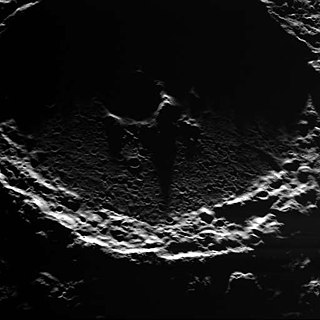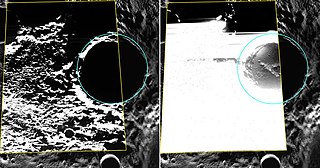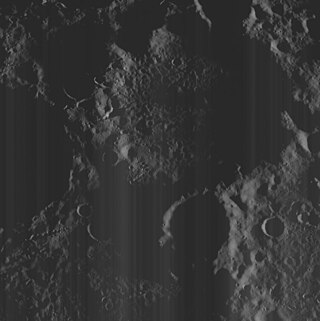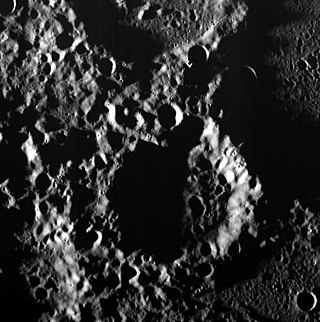
The geology of Mercury is the scientific study of the surface, crust, and interior of the planet Mercury. It emphasizes the composition, structure, history, and physical processes that shape the planet. It is analogous to the field of terrestrial geology. In planetary science, the term geology is used in its broadest sense to mean the study of the solid parts of planets and moons. The term incorporates aspects of geophysics, geochemistry, mineralogy, geodesy, and cartography.
A cold trap is a concept in planetary sciences that describes an area cold enough to freeze (trap) volatiles. Cold-traps can exist on the surfaces of airless bodies or in the upper layers of an adiabatic atmosphere. On airless bodies, the ices trapped inside cold-traps can potentially remain there for geologic time periods, allowing us a glimpse into the primordial solar system. In adiabatic atmospheres, cold-traps prevent volatiles from escaping the atmosphere into space.

Berkel is a crater on the planet Mercury. Its name was approved by the IAU on July 9, 2009. It was named after the modernist painter Sabri Berkel.

Despréz is a crater on Mercury with a diameter of 47.05 kilometers. Its name was adopted by the International Astronomical Union (IAU) in 1979. Despréz is named for the French composer Josquin des Prez, who lived from 1440 to 1521.

Prokofiev is a crater near the north pole of the planet Mercury, named after the Russian composer Sergei Prokofiev. Data from the MESSENGER spacecraft indicates that it contains water ice and organic compounds. Although other craters in Mercury's north polar region are also believed to contain ice, Prokofiev is the largest of them, with probable surface ice along the southern crater floor that is in perpetual darkness.

A permanently shadowed crater is a depression on a body in the Solar System within which lies a point that is always in darkness.

Kandinsky is a deep crater on Mercury, located near the planet's north pole. It was named by the IAU in 2012 for Russian painter Wassily Kandinsky.

Tolkien is one of the northernmost craters on Mercury, located in the Borealis quadrangle at 88.82 N, 211.08 W. It is 50 km in diameter. It was named after the South African born British writer J. R. R. Tolkien. The name was approved by IAU's Working Group for Planetary System Nomenclature on August 6, 2012. Since Tolkien is very close to the north pole, and Mercury has almost no axial tilt, Tolkien receives very little sunlight. S band radar data from the Arecibo Observatory collected between 1999 and 2005 indicates a radar-bright area covers the entire floor of Tolkien, which is probably indicative of a water ice deposit.

Kulthum is a crater on Mercury. It has a diameter of 31 kilometers. Its name was suggested by Molouk Ba-Isa from Saudi Arabia, Swiss individual Riana Rakotoarimanana, and American residents Yehya Hassouna, David Suttles, Thorayya Said Giovannelli and Matt Giovannelli in a naming contest which was eventually adopted by the International Astronomical Union (IAU) on 2015. Kulthum is named for the Egyptian singer Umm Kulthum.

Vonnegut is a crater on Mercury, near the north pole. It was named by the IAU in 2017 after the American author Kurt Vonnegut. Part of Vonnegut's 1959 novel The Sirens of Titan takes place on Mercury. The crater was referred to as e5 in scientific literature prior to naming.

Yoshikawa is a crater on Mercury, near the north pole. It was named by the IAU in 2012 after the Japanese novelist Eiji Yoshikawa.

Sapkota is a crater on Mercury, located near the north pole. It was named by the IAU in 2015, after Nepalese poet Mahananda Sapkota.

Laxness is a crater on Mercury, located near the north pole. It was named by the IAU in 2013, after Icelandic writer Halldór Laxness.

Fuller is a crater on Mercury, located near the north pole. It was named by the IAU in 2013, after American engineer and architect Richard Buckminster Fuller.

Tryggvadóttir is a crater on Mercury. The north pole of Mercury is located next to its northern rim. It was named by the IAU in 2012 after the Icelandic artist Nína Tryggvadóttir.

Chesterton is a crater on Mercury, near the north pole. Its name was adopted by the International Astronomical Union in 2012, after the English author G. K. Chesterton.

Gordimer is a crater on Mercury, near the north pole. Its name was adopted by the International Astronomical Union (IAU) in 2019, after the South African writer Nadine Gordimer.

Yamada is a crater on Mercury. It has a diameter of 17.1 kilometres. Its name was adopted by the International Astronomical Union (IAU) on November 4, 2015. Yamada is named for the Japanese composer and conductor Kosaku Yamada. The crater was referred to as n5 in scientific literature prior to naming.

Bunin is a crater on Mercury, located near the north pole. Its name was adopted by the International Astronomical Union (IAU) in 2019. It is named for the Russian author Ivan Bunin. The crater was referred to as l7 in scientific literature prior to naming.

Josetsu is a crater on Mercury, located near the north pole. Its name was adopted by the International Astronomical Union (IAU) in 2019. It is named for the Japanese painter Taikō Josetsu. The crater was referred to as o7 in scientific literature prior to naming.

















